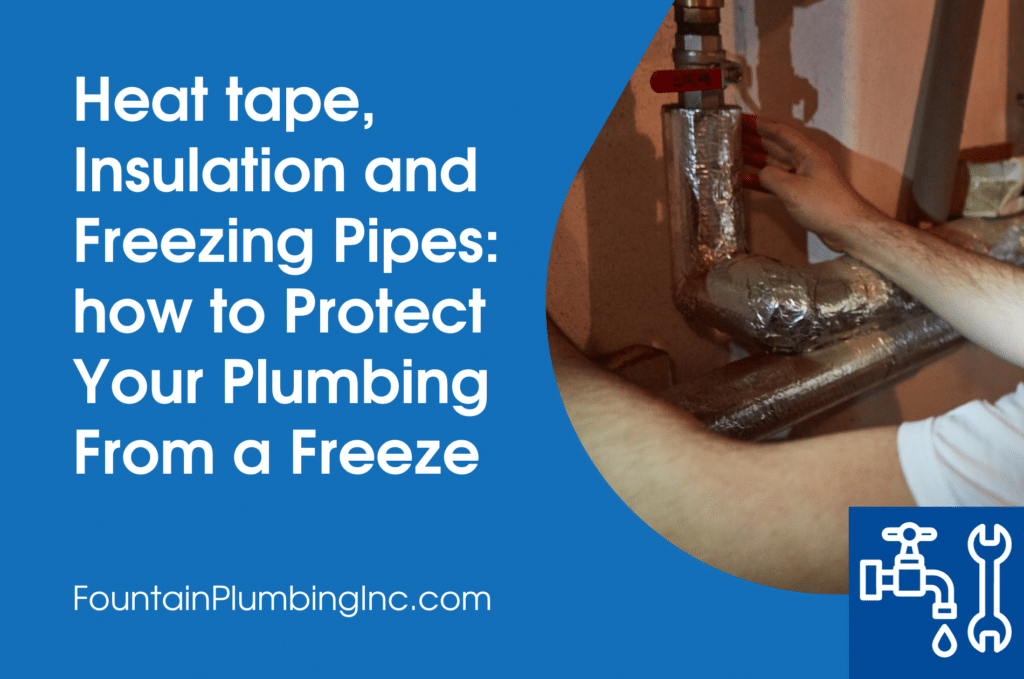Heat wrap for pipes isn’t a big Texas topic, but we do get freezes hard enough to burst pipes. Want to be ready for a hard freeze? Prepare your home’s pipes with electric heat tape or pipe insulation. It is a whole lot cheaper than fixing burst pipes.
Heat wrap, insulation, and protection from the elements: Think layers
Think of wrapping pipes to prevent freezing as part of a pipe protection system. A system of layers starting first with protecting outside pipes from the elements and then moving to the pipes as the final layer.
Any pipe exposed to the outside elements needs an enclosure. The enclosure could be insulated to add a layer of protection. Finally, you can wrap outside pipes with electric heat tape or other insulation as a final layer.
Layering is not wrapping any pipe with one insulation layer and then putting pipe wrap heat tape on top of that. This is not safe.
Indoor pipes generally don’t need thermal protection because they’re located in the home. However, if you have indoor pipes that are run through an outside facing wall, or in a space that is exposed to an outside facing wall, you may think about putting insulation wrap on those pipes.
Types of pipe wrap insulation
Pipe wrap insulation can be tubing type foam split along the side allowing it to be simply pushed onto the pipe. You find the tubing at any hardware store and it is sized for various diameter pipes.
Rolled pipe wrap insulation is, as it says, a roll of insulation that spiral wraps around the pipe to be protected. What’s nice about rolled insulation is it’s one size fits all characteristic.
Electric heat tape pipe insulation wraps around the pipe to be protected like regular roll type. But the difference is it is an electric current carrying conductor. The flow of electric current creates enough heat around the pipe to keep water above freezing.
Installing electric heat tape to keep pipes from freezing
Electric heat tape requires the most consideration when installing. Always follow the manufacturers recommendations when using electric heat tape and be aware that improperly installed electric heat tape is a serious fire hazard.
Pay attention to the type of pipe you’re wrapping with electric heat tape. Some plastic piping, especially in mobile homes, is not capable of using electric heat tape. If your application is heating water pipes in mobile home crawl space be sure to check the pipe construction and the electric heat tape specifications.
Power is supplied to electric heat type by either plugging it into a properly installed 110vac receptacle, or by hardwiring the connection to a junction panel.
Fire professionals recommend you hire a pro if you’re unsure about installation. They point out that fires often occur if the pipe wrap insulation tape overlaps itself on the pipe. Meaning that you should not have any section of the wrap on heat tape touching or on top of another section. This causes arcing and that’s a problem.
Automatic regulation of electric heat tape
Obviously if it’s above freezing temperatures there’s no need to have electric heat tape powered up. So, there’s a thermostat designed to sense temperature and turn the heat tape on automatically when needed.
When properly attached, the thermostat is located at the coldest location needing protection.
Where to use heat tape wrap
Wrapping outdoor pipes with wrap on heat tape is a better choice than simple insulation like foam wrapping. Or, if you have a crawl space where pipes are near the outside wall you may think of heat wrap on those pipes.
There are different ratings for enclosed and unenclosed uses. If the pipe is outside, then you want to find outdoor pipe insulation wrap. Outdoor pipe insulation wrap is designed to work in the elements.
Wrap on heat tape and safety
If, on the other hand you’re wondering what to do as you’re watching the thermometer get below 32’ to keep your pipes happy, we’ll talk about that too.
Whichever situation you’re in, when you wrap pipes to prevent freezing you use the same idea when you wrap yourself to keep from freezing. Think layers! You want as many layers between your home’s pipe and the cold weather as possible.

